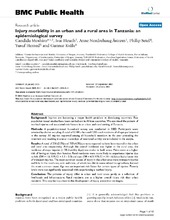| dc.contributor.author | Moshiro, Candida Simon | en_US |
| dc.contributor.author | Heuch, Ivar | en_US |
| dc.contributor.author | Åstrøm, Anne Nordrehaug | en_US |
| dc.contributor.author | Setel, Philip | en_US |
| dc.contributor.author | Hemed, Yusuf | en_US |
| dc.contributor.author | Kvåle, Gunnar | en_US |
| dc.date.accessioned | 2014-09-12T06:51:13Z | |
| dc.date.available | 2014-09-12T06:51:13Z | |
| dc.date.issued | 2005-01-28 | eng |
| dc.identifier.issn | 1471-2458 | |
| dc.identifier.uri | https://hdl.handle.net/1956/8456 | |
| dc.description.abstract | Background: Injuries are becoming a major health problem in developing countries. Few population based studies have been carried out in African countries. We examined the pattern of nonfatal injuries and associated risk factors in an urban and rural setting of Tanzania. Methods: A population-based household survey was conducted in 2002. Participants were selected by cluster sampling. A total of 8,188 urban and 7,035 rural residents of all ages participated in the survey. All injuries reported among all household members in the year preceding the interview and resulting in one or more days of restricted activity were included in the analyis. Results: A total of 206 (2.5%) and 303 (4.3%) persons reported to have been injured in the urban and rural area respectively. Although the overall incidence was higher in the rural area, the incidence of major injuries (≥ 30 disability days) was similar in both areas. Males were at a higher risk of having an injury than females. Rural residents were more likely to experience injuries due to falls (OR = 1.6; 95% CI = 1.1 – 2.3) and cuts (OR = 4.3; 95% CI = 3.0 – 6.2) but had a lower risk of transport injuries. The most common causes of injury in the urban area were transport injuries and falls. In the rural area, cuts and stabs, of which two thirds were related to agriculture, formed the most common cause. Age was an important risk factor for certain types of injuries. Poverty levels were not significantly associated with experiencing a nonfatal injury. Conclusion: The patterns of injury differ in urban and rural areas partly as a reflection of livelihoods and infrastructure. Rural residents are at a higher overall injury risk than urban residents. This may be important in the development of injury prevention strategies. | en_US |
| dc.language.iso | eng | eng |
| dc.publisher | BioMed Central | eng |
| dc.rights | Attribution CC BY | eng |
| dc.rights.uri | http://creativecommons.org/licenses/by/2.0 | eng |
| dc.title | Injury morbidity in an urban and a rural area in Tanzania: an epidemiological survey | en_US |
| dc.type | Peer reviewed | |
| dc.type | Journal article | |
| dc.date.updated | 2013-08-28T17:17:54Z | |
| dc.description.version | publishedVersion | en_US |
| dc.rights.holder | Candida Moshiro et al.; licensee BioMed Central Ltd. | |
| dc.rights.holder | Copyright 2005 Moshiro et al; licensee BioMed Central Ltd. | |
| dc.source.articlenumber | 11 | |
| dc.identifier.doi | https://doi.org/10.1186/1471-2458-5-11 | |
| dc.identifier.cristin | 406907 | |
| dc.source.journal | BMC Public Health | |
| dc.source.40 | 5 | |

